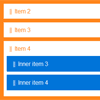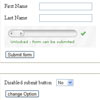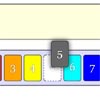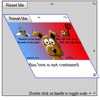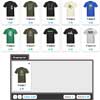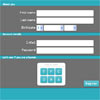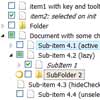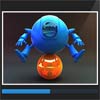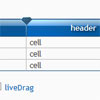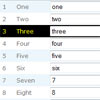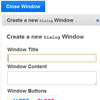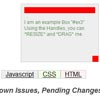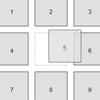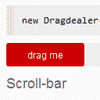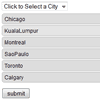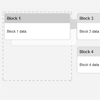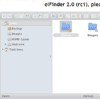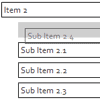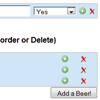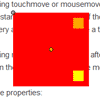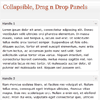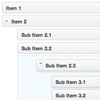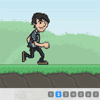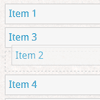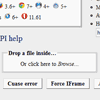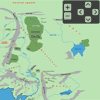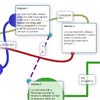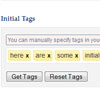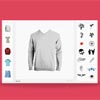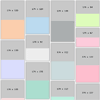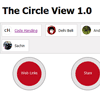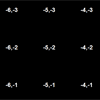HTML5Sortable
Lightweight vanillajs micro-library for creating sortable lists and grids using native HTML5 drag and drop API.
Community maintained
A fair warning: this repository is currently not being actively developed. It works pretty fine, but if you find any issues you will need to fix them yourself. I try to keep the dependencies up to date and will happily help you fix issues and merge PRs for bugfixes or new features.
Looking for Co-Maintainer
If you are interested in actively helping with maintaining & improving this project please send me a message via twitter @lukasoppermann or email [email protected] with a short text of what you would like to do on the project. This may be something small like sorting issues and helping with questions and small bugs (if you have little time or are not that experienced) or something big like tackling big features.
Features
- Only 2KB (minified and gzipped).
- Built using native HTML5 drag and drop API. No dependencies.
- Supports both list and grid style layouts.
- Supported Browsers: Current versions of all major browsers (Chrome, Firefox, Safari, Opera, Edge), IE11+ (Polyfill required)
- Available as ES6 Module, AMD, CommonJS and iffe with
sortableglobal
Demo: Check out the examples
Framework adapters
If you would like to add an adapter to the list, please create an issue with the link to your adapter.
Installation
We recommend installing the package via npm.
npm install html5sortable --save Once you install the package using npm or downloading the latest release (don't use the master branch), load file you need from the dist/ directory, e.g. dist/html.sortable.min.js for the minified iife version.
- iffe (loading file via script tag):
dist/html5sortable.jsordist/html5sortable.min.js - ES6 Module:
dist/html5sortable.es.js - CommonJS Module:
dist/html5sortable.cjs.js - AMD Module:
dist/html5sortable.amd.js
Still using bower? bower install https://github.com/lukasoppermann/html5sortable.git
Examples
You can find the examples online or test locally. Warning: the online demo is just to show off the features and is most likely not up to date. Please study this readme file for the current way of implementing and using html5sortable.
Usage
Use sortable method to create a sortable list:
sortable('.sortable');Styling
Use .sortable-placeholder CSS selectors to change the styles of the placeholder. You may change the class by setting the placeholderClass option in the config object.
sortable('.sortable', { placeholderClass: 'my-placeholder fade' });Nesting
You can nest sortables inside each other. However, take care to add a wrapper around the items, a sortable-item can not at the same time be a sortable.
<div class="list"><!-- Sortable --> <div class="item"> Item 1 <div class="sublist"><!-- Nested Sortable; Wrapping container needed --> <div class="subitem">Subitem 1</div> <div class="subitem">Subitem 2</div> </div> </div> <div class="item"> Item 2 </div> </div>Events
NOTE: Events can be listened on any element from the group (when using connectWith), since the same event will be dispatched on all of them.
sortstart
Use sortstart event if you want to do something when sorting starts:
sortable('.sortable')[0].addEventListener('sortstart', function(e) { /* This event is triggered when the user starts sorting and the DOM position has not yet changed. e.detail.item - {HTMLElement} dragged element Origin Container Data e.detail.origin.index - {Integer} Index of the element within Sortable Items Only e.detail.origin.elementIndex - {Integer} Index of the element in all elements in the Sortable Container e.detail.origin.container - {HTMLElement} Sortable Container that element was moved out of (or copied from) */ });sortstop
Use the sortstop event if you want to do something when sorting stops:
sortable('.sortable')[0].addEventListener('sortstop', function(e) { /* This event is triggered when the user stops sorting and the DOM position has not yet changed. e.detail.item - {HTMLElement} dragged element Origin Container Data e.detail.origin.index - {Integer} Index of the element within Sortable Items Only e.detail.origin.elementIndex - {Integer} Index of the element in all elements in the Sortable Container e.detail.origin.container - {HTMLElement} Sortable Container that element was moved out of (or copied from) */ });sortupdate
Use sortupdate event if you want to do something when the order changes (e.g. storing the new order):
sortable('.sortable')[0].addEventListener('sortupdate', function(e) { console.log(e.detail); /* This event is triggered when the user stopped sorting and the DOM position has changed. e.detail.item - {HTMLElement} dragged element Origin Container Data e.detail.origin.index - {Integer} Index of the element within Sortable Items Only e.detail.origin.elementIndex - {Integer} Index of the element in all elements in the Sortable Container e.detail.origin.container - {HTMLElement} Sortable Container that element was moved out of (or copied from) e.detail.origin.itemsBeforeUpdate - {Array} Sortable Items before the move e.detail.origin.items - {Array} Sortable Items after the move Destination Container Data e.detail.destination.index - {Integer} Index of the element within Sortable Items Only e.detail.destination.elementIndex - {Integer} Index of the element in all elements in the Sortable Container e.detail.destination.container - {HTMLElement} Sortable Container that element was moved out of (or copied from) e.detail.destination.itemsBeforeUpdate - {Array} Sortable Items before the move e.detail.destination.items - {Array} Sortable Items after the move */ });Options
items
Use the items option to specify which items inside the element should be sortable:
sortable('.sortable', { items: ':not(.disabled)' });handle
Use the handle option to restrict drag start to the specified element:
sortable('.sortable', { handle: 'h2' });forcePlaceholderSize
Setting the forcePlaceholderSize option to true, forces the placeholder to have a height:
sortable('.sortable', { forcePlaceholderSize: true });connectWith 
Use acceptFrom instead. The connectWith option allows you to create a connected lists:
sortable('.js-sortable, .js-second-sortable', { connectWith: 'connected' // unique string, which is not used for other connectWith sortables });acceptFrom
Use the acceptFrom option to restrict which sortable's items will be accepted by this sortable. acceptFrom accepts a space separated list of selectors or false to disabling accepting items. This is an alternative to connectWith and should not be used together.
sortable('.sortable', { acceptFrom: '.selector,.anotherSortable' // Defaults to null });If you want to be able to move items between to sortables, the acceptFrom option must be present on both of them.
placeholder
Use the placeholder option to specify the markup of the placeholder:
sortable('.sortable', { items: 'tr' , placeholder: '<tr><td colspan="7"> </td></tr>' });hoverClass
Use the hoverClass option to apply css classes to the hovered element rather than relying on :hover. This can eliminate some potential drag and drop issues where another element thinks it is being hovered over.
sortable('.sortable', { hoverClass: 'is-hovered is-hovered-class' // Defaults to false });maxItems
Use the maxItems option to restrict the number of items that can be added to a sortable from a connected sortable. maxItems should always be combined with the items option. Make sure items does not match placeholder and other options, so that they are not counted.
sortable('.sortable', { maxItems: 3 // Defaults to 0 (no limit) });copy
Use the copy option to duplicate the element on drag. The original element will remain in the same position.
sortable('.sortable', { copy: true // Defaults to false });itemSerializer
You can provide a function that will be applied to every item in the items array (see serialize). The function receives two arguments: serializedItem: object, sortableContainer: Element. This function can be used to change the output for the items. Defaults to undefined.
sortable('.sortable', { itemSerializer: (serializedItem, sortableContainer) => { return { position: serializedItem.index + 1, html: serializedItem.html } } });containerSerializer
You can provide a function that will be applied to the container object (see serialize). The function receives one argument: serializedContainer: object. This function can be used to change the output for the container. Defaults to undefined.
sortable('.sortable', { containerSerializer: (serializedContainer) => { return { length: container.itemCount } } });customDragImage
You can provide a function as a customDragImage property on the options object which will be used to create the item and position of the drag image (the half transparent item you see when dragging an element).
The function gets three parameters, the dragged element, an offset object with the offset values for the offset of the item and the dragstart event. The function MUST return an object with an element property with an html element as well as a posX and posY property with has the x and y offset for the dragImage.
sortable('.sortable', { customDragImage: (draggedElement, elementOffset, event) => { return { element: draggedElement, posX: event.pageX - elementOffset.left, posY: event.pageY - elementOffset.top } } }); // elementOffset object that is received in the customDragImage function { left: rect.left + window.scrollX, right: rect.right + window.scrollX, top: rect.top + window.scrollY, bottom: rect.bottom + window.scrollY }Methods
destroy
To remove the sortable functionality completely:
sortable('.sortable', 'destroy');disable
To disable the sortable temporarily:
sortable('.sortable', 'disable');enable
To enable a disabled sortable:
sortable('.sortable', 'enable');serialize
You can easily serialize a sortable using the serialize command. If you provided an itemSerializer or containerSerializer function in the options object, they will be applied to the container object and the items objects before they are returned.
sortable('.sortable', 'serialize'); // You will receive an object in the following format [{ container: { node: sortableContainer, itemCount: items.length } items: [{ parent: sortableContainer, node: item, html: item.outerHTML, index: index(item, items) }, …] }, …]reload
When you add a new item to a sortable, it will not automatically be a draggable item, so you will need to reinit the sortable. Your previously added options will be preserved.
sortable('.sortable');Sorting table rows
- Initialize plugin on
tbodyelement (browsers automatically addtbodyif you don't) - Keep in mind that different browsers may display different drag images of the row during the drag action. Webkit browsers seem to hide entire contents of
tdcell if there are any inline elements inside thetd. This may or may not be fixed by setting thetdto beposition: relative; - If you add a custom
placeholderyou must use atre.g.placeholder: "<tr><td colspan="3">The row will appear here</td></tr>", otherwise you will only be able to drop items when hovering the first column.
Contributing
This version is maintained by Lukas Oppermann and many other contributors. Thanks for your help!
Contributions are always welcome. Please check out the contribution guidelines to make it fast & easy for us to merge your PR.
Polyfills: Facing towards the future instead of the past
This project is focusing on modern, evergreen browsers to deliver a fast and small package. While many projects try build features so that it runs in the oldest browser (looking at you IE9), we try to create a fast and pleasant development experience using the language capabilities that the current version of Javascript offers.
Benefits
Small and fast package for modern browsers
While a backwards facing approach penalises modern browsers by making them download huge files, we prefer to ship a small package and have outdated browser bear the penalty of the polyfill. An additional benefit is that you might polyfill those features in any case so you don't have any additional load.
Contribution friendly code base
We try to encourage people to help shape the future of this package and contribute in small or big ways. By removing hard to understand hacks we make it easier for people new to the code base or even Javascript to contribute.
Helps browser optimisation
Browser try to performance optimise language features as much as possible. Working around the language to make code work in outdated browser may actually work against this.
Polyfill
We recommend using the Financial Times Polyfill Service which will polyfill only the necessary features for browsers that need a polyfill. It is basically a no-config, easy solution.
<script src="https://cdn.polyfill.io/v2/polyfill.min.js"></script> Known Issues
Firefox
- Dragstart not working on buttons
Dragstart event does not fire onbuttonelements. This effectively disables drag and drop for button elements. See https://caniuse.com/#feat=dragndrop in the known issues section.
